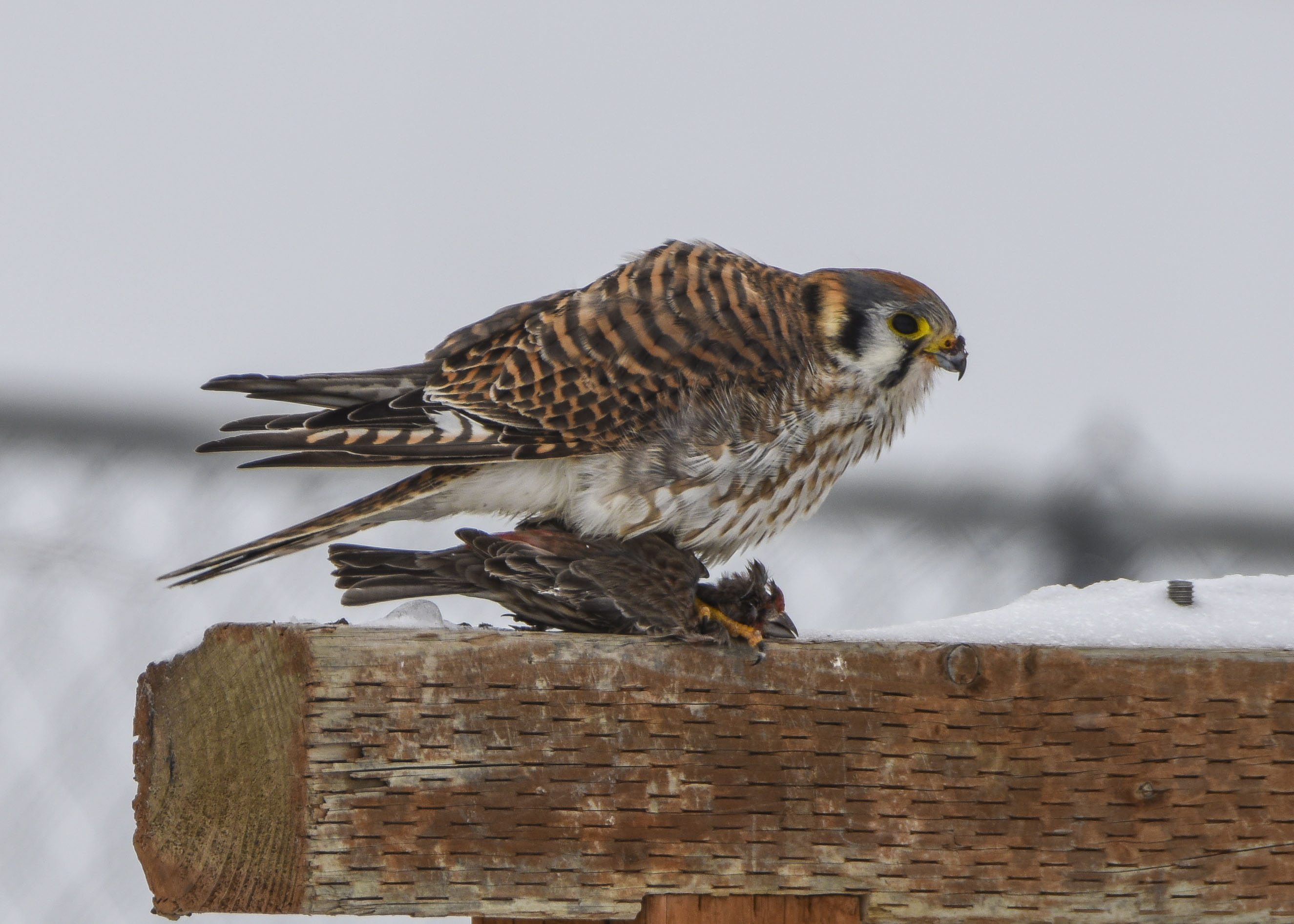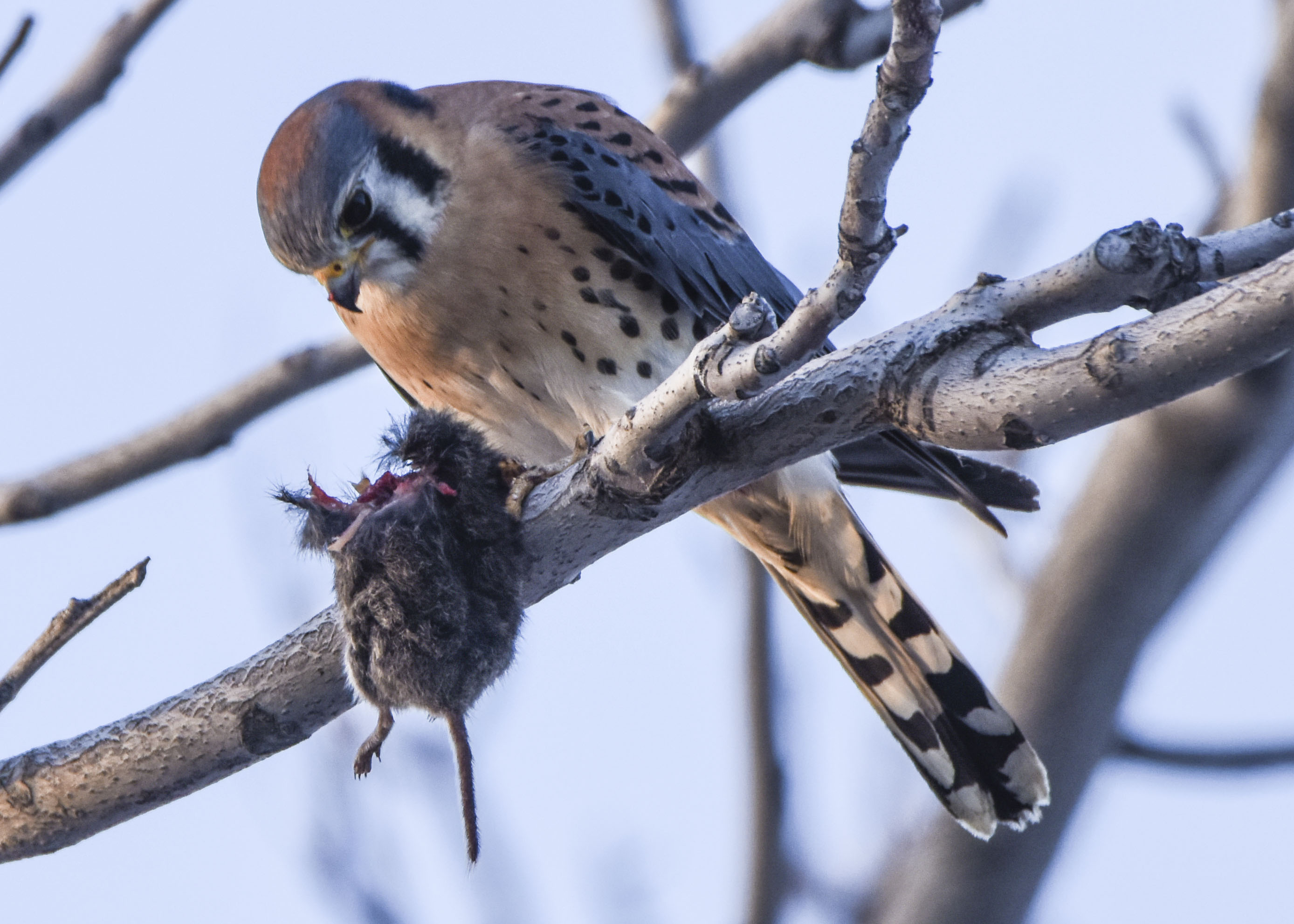American Kestrel
Falco sparverius
American kestrels are widespread falcons, occurring from southern South America to Alaska. They are called the American kestrel because they only occur in the New World (there is an Old World version, but it is considered a separate species).
Out of a field of 60 species, kestrels are the smallest and most colorful of the falcons which include caracaras, falconets, pygmy falcons, forest falcons, and falcons.
Kestrels are about the size of a mourning dove with a streamlined body and the characteristic hooked beak of a bird of prey. Their head and cheeks sport distinctive vertical striping of alternating white and black, they have a yellow sere and a dark beak. Taloned feet are a bright yellow.
Both sexes have a blue-gray cap from forehead to the back of the head, but the male may also have a rusty brown cap. The female has rust-brown wings and back; the male has blue-gray wings. The chest is the same striking rusty brown. They may have black spotting throughout.
Seen from below, the wings are almost a checkerboard of black and white from tip to body. They have a black band on the tail and it is wider on males than females.
Behavior and Habitat
Kestrels hunt mice, voles, small reptiles, and birds, but large insects make up the bulk of their summer diet. They usually take their prey from the ground. However, they can sometimes be seen hunting around stadium lights that attract insects such as moths and may hunt bird feeders during the winter.
Kestrels do not build their own nests. They use nesting cavities constructed by other birds. They readily take to manmade boxes as well. They also do not place any nesting material on the bottom of the nest. Four to five eggs are laid right on the substrate.
Kestrels often kill more prey than they can consume at one time. They hide the excess in clumps of grass, in tree cavities, under bushes and just about any other secure place they can find. This serves them well when prey is scarce.
Kestrels are habitat generalists. They can be found hunting from alpine tundra to desert floor and everything in between. However, they prefer more open country and are seldom seen in forests.
Similar Species
Because of their habit of perching on powerlines, kestrels are often mistaken for mourning doves. Look carefully whenever you see a bird perched on a line, pole or fence. It might just be a kestrel.
The Merlin, another small falcon, is the closest thing to a kestrel in looks. It is slightly larger than a kestrel. It lacks the distinctive rusty brown color of the kestrel, it is darker overall and the chest and belly appear more striped and less spotted than the kestrel. According to the official bird list, merlins are considered only occasional visitors to Camas NWR.
Sharp-shinned hawks are about kestrel-sized, but they are accipiters, not falcons. They have broad rounded wings instead of pointed wings, a longer tail and lack distinctive vertical face stripes of the kestrel. Overall, they are brownish and don’t have any of the slate-blue color.
Cool Facts
“Unlike humans, birds can see ultraviolet light. This enables kestrels to make out the trails of urine that voles, a common prey mammal, leave as they run along the ground. Like neon diner signs, these bright paths may highlight the way to a meal—as has been observed in the Eurasian Kestrel, a close relative”. http://www.hawkmountain.org
Since kestrels occupy such a wide range north to south, it is to be expected that migration is not uniform. Kestrels from the furthest north migrate the farthest while kestrels in the southern parts may not migrate at all. Females usually migrate first and select the more open areas. Late arriving males are forced to the more wooded habitats.
When and where found at Camas NWR
While common other times of the year, now that winter is setting in, you may or may not see kestrels on Camas NWR. Watch for them on powerlines and hunting the open marshes for voles and mice now that insects aren’t available.
Conservation
“The American Kestrel is the continent’s most common and widespread falcon but populations declined by about 50% between 1966 and 2015, according to the North American Breeding Bird Survey. Partners in Flight estimates the global breeding population at 4 million, with 39% spending some part of the year in the U.S., 10% in Mexico, and 13% breeding in Canada. They rate an 11 out of 20 on the Continental Concern Score and are not on the 2016 State of North America's Birds' Watch List. Current declines stem from the continued clearing of land and felling of the standing dead trees these birds depend on for their nest sites. The American Kestrel is also losing prey sources and nesting cavities to so-called “clean” farming practices, which remove hedgerows, trees, and brush. An additional threat is an exposure to pesticides and other pollutants, which can reduce clutch sizes and hatching success. For kestrels in North America, a larger problem with pesticides is that they destroy the insects, spiders, and other prey on which the birds depend.” www.allaboutbirds.org/guide/American_Kestrel/lifehistory
Text by Terry Thomas. Source: https://www.allaboutbirds.org and http://www.hawkmountain.org
Photos by Terry Thomas.

A female kestrel consumes a house finch at a bird feeder.

A male kestrel with his vole for dinner.